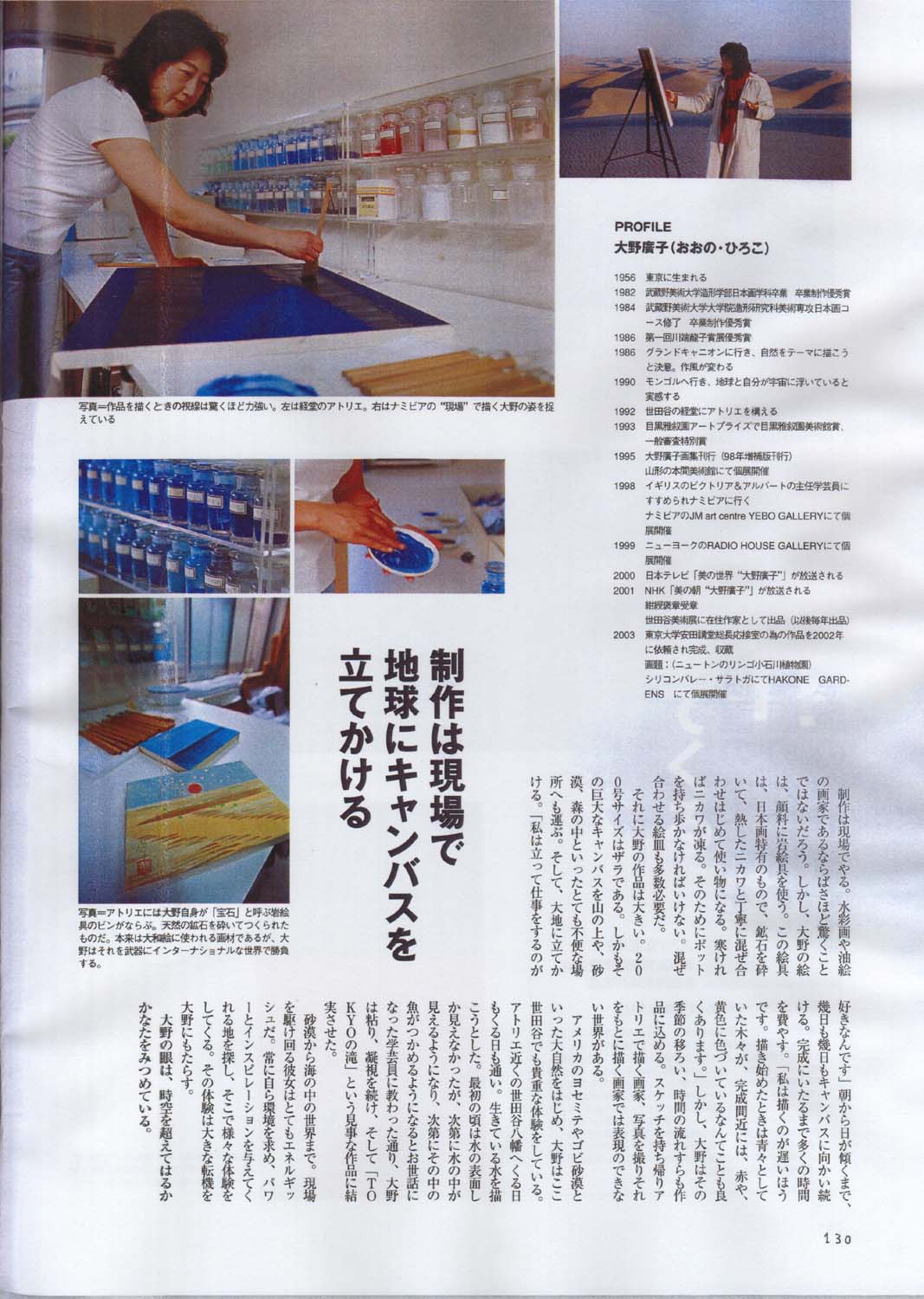

I paint on location -- I set up my canvas on the earth itself.
Ohno paints on location. It is not so surprising for an oil painter or a watercolor artist. But Ohno, a Japanese painter uses pigments and mineral paints. These paints are unique to Japanese painting. Minerals must be ground and mixed painstakingly with heated glue before it can be used. When the temperature is cold, the glue hardens. That is why Ohno always carries a thermos. Many dishes to mix the paint in are also a necessity.
In addition, Ohno's works are enormous. It is not unusual for her to paint a size 200 canvas. She carries such oversized canvasses to extremely inconvenient locations like the mountain, desert, and forest. There, she sets up her canvas on the earth. "I like to paint standing up," says Ohno. From morning to sunset, she paints her canvas for many days, taking a long time until completion. "It takes time for me to paint a work. The leaves may be green when I start, but often they turn red and yellow by the time I complete a painting." Nevertheless, Ohno captures even such changing of the seasons, the passing of time in her works. Hers is a world that cannot be expressed by an artist who sketches or takes photographs outdoors and paints in the studio.
In addition to her contact with the great nature of Yosemite, USA, and the Gobi Desert, Ohno has had a precious experience here in Setagaya. She has visited Setagaya Hachiman near her studio day in and day out to paint living water. Following the advice of a helpful curatorial worker who told her you can only see the water's surface at first, but gradually you are able to see under the water and capture the fish living there, Ohno persistently continued gaze at the water and created a magnificent piece titled TOKYO Waterfall.
From the desert to the underwater world, Ohno energetically journeys through her production sites. Always searching for her environment, looking for a location that would give her power and inspiration, she experiences many things wherever she goes. Such experiences offer Ohno a major turning point.
Ohno's eyes continue to gaze far beyond time and space.
PROFILE
Hiroko Ohno
1956 Born in Tokyo.
1982 Graduated from the Japanese Painting Department of Musashino University of Art. Received Award of Excellence for graduation project.
1984 Completed graduated studies in the Japanese Painting Course, Fine Arts Major, Musashino Art University. Received Award of Excellence for course completion project.
1985 Received the Award of Excellence at the 1st Ryushi Kawabata Award Exhibition.
1986 Traveled to Grand Canyon, and started to paint nature, changed style of work hereafter.
1990 Traveled to Mongolia, experienced a sensation of floating in the universe.
1992 Obtained a studio in Kyodo, Setagaya.
1993 Received Meguro Gajoen Museum Award and General Judgefs Special Award in Meguro Gajoen Art Prize.
1995 Published a Book of Collected Works. (revised and enlarged edition published in '98)
1998 Traveled to Namibia, Africa advised by Chief Curator of the Victoria and Albert Museum, UK.
Held solo exhibition at YEBO Gallery, JM Art Centre, Namibia.
1999 Held solo exhibition at Radio House Gallery, New York.
2000 gThe World of Beauty -- Hiroko Ohnoh televised on NTV.
2001 gThe Morning of Beauty -- Hiroko Ohnoh televised on NHK.
Awarded the Dark-blue Ribbon Medal.
Exhibited in Setagaya Art Exhibition as resident artist. (exhibiting annually thereafter)
2003 Completed work that was commissioned in 2002 for the presidentfs drawing room of Tokyo University Yasuda Auditorium, titled An Apple of Newton --The Koishikawa Botanical Garden.
Held solo exhibition at Hakone Gardens, Silicon Valley, Saratoga.
Photo: Her gaze is intense as she paints. Right, Ohno's studio in Kyodo. Left, Ohno painting "on location" in Namibia.
Photo: Rows of bottled mineral paints in the studio, which Ohno calls "jewels."
The paints are made of powdered natural minerals, traditionally used in
Yamato-e. They are Ohno's materials to express herself internationally.